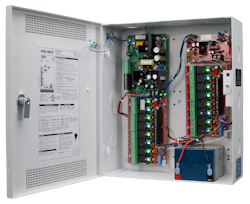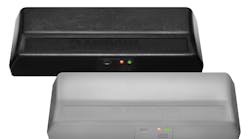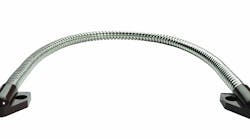Access control systems are critical to protecting people and property. When you look for a power supply for access control devices, make sure to look for one that can handle electronic locks and strikes, card readers, sensors and more. More than anything, you’ll want reliable performance.
Unfortunately, power supplies too often are treated as an afterthought during the building design process. Putting an emphasis on power at the onset of design ensures a seamless access control experience, because it takes into account how power interacts with the rest of the building (or buildings), including the performance and monitoring of electrified door openings, whether it be for the smallest single-door systems or the largest enterprise systems.
To maintain a safe and secure space, security professionals are responsible for choosing the right power supplies for the access control systems they install.
One Step Further
Choosing the right power supply warrants a review of what’s in the market. Of course, as seems to be the case with an increasing number of security products, the next evolution of power supplies incorporates intelligence and the opportunity for remote supervision, testing and reporting. This is known as managed power.
Managed power delivers intelligence and networking functionality to make the power supply capable of monitoring, testing and analyzing system power in a proactive fashion. It accomplishes this by gathering live system data over an intelligent network, which makes the power supply more efficient and reliable. In doing so, managed power provides a more consistent operation and assures a strong return on investment (ROI) for property owners and managers in the process.
The Securitron AQL Intelligent Power Supply Series by ASSA ABLOY is a new line of power supplies that includes managed power. It was created after ASSA ABLOY acquired LifeSafety Power in 2019 as a complement to its access control portfolio to provide more flexibility, modularity and scalability, whether that’s at the time of the installment or at any time in the future.
From a technical perspective, power supplies must be sized correctly to avoid a system failure or a decreased device lifespan. The flexible design of the Securitron AQL leaves room for increased functionality or upgrades to keep up with changing system requirements. Network monitoring capabilities provide real-time data to monitor battery life and health, which allows users and installers to detect potential problems before they happen. Network monitoring also allows for one-click or scheduled remote battery tests, reporting on battery-charge status as well as standby time without requiring a technician to be on-site.
Considering the Job
The ability to be alerted to problems, remotely diagnosing those problems and maximizing the time that the system stays up and running without having to dispatch a service vehicle are a few of the factors that contribute to the ROI of a managed-power solution. But another important factor to consider is the profitability lost to the business as the result of a system’s downtime or malfunction.
For example, if a security camera malfunctioned and required a system reboot, managed power provides a quick, remote solution. A facility manager simply can reset the system remotely. Otherwise, a technician would have to be sent to the site every time a power cycle was required. By centralizing the power source and reducing the necessity for third-party technicians, facility managers gain more control over their system — and save time and money while they’re at it.
A one-click or scheduled battery test for every power supply in a building, even across a campus environment, is another benefit of managed power. After a battery test is complete, a facility manager knows exactly what condition the batteries are in and can swap aging or damaged batteries out quickly. This keeps facilities up and running longer without any surprise outages.
Finally, it's necessary to monitor the environment. In a traditional power system, a failure might not be known until the end user realizes their door no longer is secure. The fix could require multiple steps from a dispatched technician over the course of a few hours or even days. It’s bad enough if that’s for a single door, but if the power system manages an extensive security system, a problem could require full-time security personnel to secure the area — an expensive development. Proactive alerts become valuable in these situations to identify impending failures and allow for replacements ahead of time with essentially no down time as a result.
Problem Solving with Power
Whether it’s experiencing one or a mix of the above situations, managed-power power supplies provide for compelling ROI. A managed-power solution most often will increase efficiency, security and the profitability of any installation.
Power supplies are the heartbeat of every system, from a single office to an entire building or even a sprawling campus. As such, determining how you harness, deliver and manage that power shouldn’t be an afterthought. Ensuring that customers’ systems will function properly requires reliable power before any other solution is implemented.
Incorporating intelligence is one of the most reliable ways to manage power proactively and, thus, create a consistent operation.
Lissette Tuminello is product manager of ASSA ABLOY Electromechanical Specialties.





